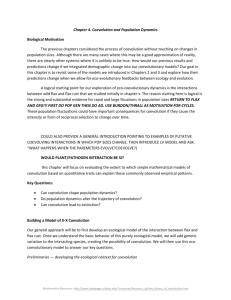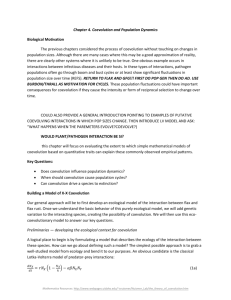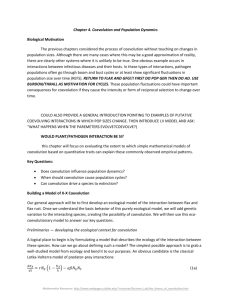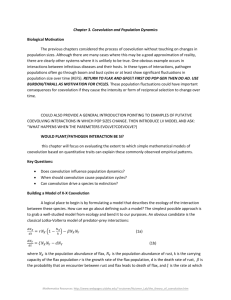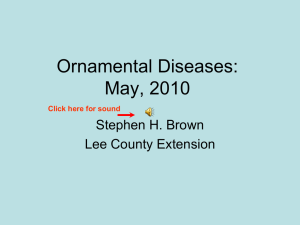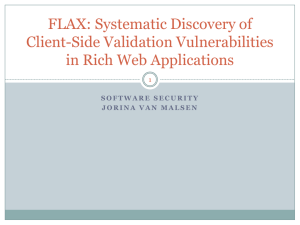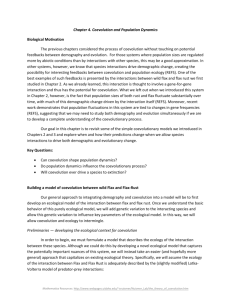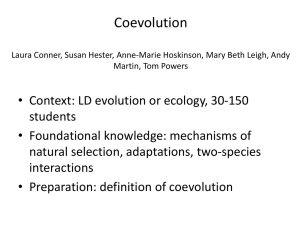Chapter 4. Coevolution and Population Dynamics Biological
advertisement
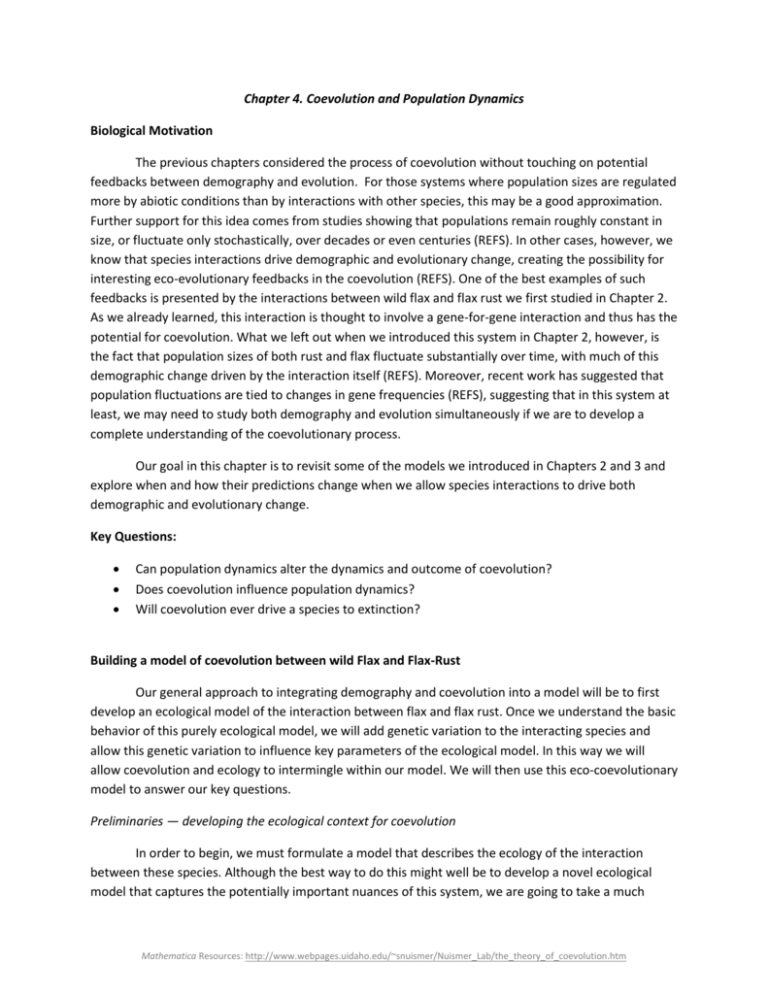
Chapter 4. Coevolution and Population Dynamics
Biological Motivation
The previous chapters considered the process of coevolution without touching on potential
feedbacks between demography and evolution. For those systems where population sizes are regulated
more by abiotic conditions than by interactions with other species, this may be a good approximation.
Further support for this idea comes from studies showing that populations remain roughly constant in
size, or fluctuate only stochastically, over decades or even centuries (REFS). In other cases, however, we
know that species interactions drive demographic and evolutionary change, creating the possibility for
interesting eco-evolutionary feedbacks in the coevolution (REFS). One of the best examples of such
feedbacks is presented by the interactions between wild flax and flax rust we first studied in Chapter 2.
As we already learned, this interaction is thought to involve a gene-for-gene interaction and thus has the
potential for coevolution. What we left out when we introduced this system in Chapter 2, however, is
the fact that population sizes of both rust and flax fluctuate substantially over time, with much of this
demographic change driven by the interaction itself (REFS). Moreover, recent work has suggested that
population fluctuations are tied to changes in gene frequencies (REFS), suggesting that in this system at
least, we may need to study both demography and evolution simultaneously if we are to develop a
complete understanding of the coevolutionary process.
Our goal in this chapter is to revisit some of the models we introduced in Chapters 2 and 3 and
explore when and how their predictions change when we allow species interactions to drive both
demographic and evolutionary change.
Key Questions:
Can population dynamics alter the dynamics and outcome of coevolution?
Does coevolution influence population dynamics?
Will coevolution ever drive a species to extinction?
Building a model of coevolution between wild Flax and Flax-Rust
Our general approach to integrating demography and coevolution into a model will be to first
develop an ecological model of the interaction between flax and flax rust. Once we understand the basic
behavior of this purely ecological model, we will add genetic variation to the interacting species and
allow this genetic variation to influence key parameters of the ecological model. In this way we will
allow coevolution and ecology to intermingle within our model. We will then use this eco-coevolutionary
model to answer our key questions.
Preliminaries — developing the ecological context for coevolution
In order to begin, we must formulate a model that describes the ecology of the interaction
between these species. Although the best way to do this might well be to develop a novel ecological
model that captures the potentially important nuances of this system, we are going to take a much
Mathematica Resources: http://www.webpages.uidaho.edu/~snuismer/Nuismer_Lab/the_theory_of_coevolution.htm
easier (and hopefully more general) approach. Specifically, we are going to reach into the ecology book
sitting by my desk and grab a well-worn and well-studied model of ecological interaction from its pages.
Specifically, we are going to assume, for the sake of argument, that the ecology of the interaction
between Flax and Flax Rust can be adequately described by the (slightly modified) Lotka-Volterra model
of predator-prey interactions:
𝑑𝑁𝑋
𝑑𝑡
= 𝑟𝑁𝑋 (1 −
𝑁𝑋
)−
𝑘
𝑑𝑁𝑌
𝑑𝑡
= 𝛼𝜉𝑁𝑋 𝑁𝑌 − 𝑑𝑁𝑌 .
𝛼𝛽𝑁𝑋 𝑁𝑌
(1a)
(1b)
This system of ordinary differential equations describes how the population size of Flax (𝑁𝑋 ) and Flax
Rust (𝑁𝑌 ) change over time in response to Flax population growth (r), density dependence in the Flax
population (k), the probability that an encounter between Flax and Flax Rust leads to infection (𝛼), the
rate of death or virulence of infected Flax individuals (𝛽), the rate at which successful rust infections
churn out new rust spores (𝜉), and the rates at which free living rust spores die off (d). Unlike the
discrete time recursion equations we studied in the previous two chapters, these continuous time
differential equations are most appropriate for systems lacking discrete divisions between generations,
such that all events are always occurring at some rate (e.g., birth, death, interactions). Although many of
the analytical tools we use to study such continuous time systems are identical to those we employed in
the previous chapters (e.g., identifying equilibria), others differ slightly (e.g., stability analyses). An
ancillary goal of this chapter is to introduce you to these subtle differences in analysis of continuous
time systems.
Now that we have specified a simple ecological model, what can we learn about the ecological
dynamics of this interaction? Hopefully, we will be able to answer some simple questions such as when
both species are likely to coexist, when one or the other will go extinct, and when we might expect
fluctuations in population size like those well-documented in the Flax, Flax-Rust system. Although the
most pleasing way to tackle these questions would be to solve the system of differential equations (1)
directly, identifying such a solution is beyond the mathematical scope of this book. Fortunately, in this
case, we can answer these questions and satisfy our curiosity by identifying equilibria and assessing
their local stability.
Even though we are now working with differential equations rather than the discrete difference
equations we explored in earlier chapters, the procedure for identifying equilibria is identical: simply set
the left hand side of the equations equal to zero and solve the resulting system of equations:
0 = 𝑟𝑁𝑋 (1 −
𝑁𝑋
)−
𝑘
𝛼𝛽𝑁𝑋 𝑁𝑌
(2a)
0 = 𝛼𝜉𝑁𝑋 𝑁𝑌 − 𝑑𝑁𝑌 .
(2b)
Using only relatively simple algebra it is possible to show that there are three possible equilibrium
solutions:
𝑁𝑋 = 0 𝑎𝑛𝑑 𝑁𝑌 = 0
(3a)
2
𝑁𝑋 = 𝑘 𝑎𝑛𝑑 𝑁𝑌 = 0
𝑑
𝑁𝑋 = 𝛼𝜉 𝑎𝑛𝑑 𝑁𝑌 =
(3b)
𝑟(𝛼𝑘𝜉−𝑑)
𝛼 2 𝑘𝜉𝛽
(3c)
where the first represents extinction of both species, the second the extinction of the rust only, and the
third coexistence of both species. But when, if ever, DOES THE COEXISTENCE EQ EXIST?
Only if: 𝛼𝜉𝑘 > 𝑑
(4)
will each of these equilibria occur? To answer this question, we must analyze the local stability of these
equilibria. Just as we did for the system of discrete time equations describing changes in allele
frequencies (chapter 2), the first step is to create a Jacobian Matrix. For the system of ordinary
differential equations (2), this Jacobian Matrix is given by:
𝑟−
𝐽=[
2𝑟𝑁𝑋
𝑘
− 𝛼𝛽𝑁𝑌
𝛼𝜉𝑁𝑌
−𝛼𝛽𝑁𝑋
𝛼𝜉𝑁𝑋 − 𝑑
].
(5)
For the three ecological equilibria (3), the eigenvalues of this Jacobian are:
𝜆1 = 𝑟 𝑎𝑛𝑑 𝜆2 = −𝑑
(6a)
𝜆1 = −𝑟 𝑎𝑛𝑑 𝜆2 = 𝛼𝜉𝑘 − 𝑑
(6b)
𝜆1 =
−𝑟𝑑+√𝑟√𝑑√𝑟𝑑+4𝛼𝑑𝑘𝜉−4𝛼2 𝜉 2 𝑘 2
2𝛼𝑘𝜉
𝑎𝑛𝑑 𝜆2 =
−𝑟𝑑−√𝑟√𝑑√𝑟𝑑+4𝛼𝑑𝑘𝜉−4𝛼2 𝜉 2 𝑘 2
2𝛼𝑘𝜉
(6c)
respectively. Thankfully, we are done with the math for a bit and can now sit back and think about what
these results tell us about the ecological dynamics of our interaction. Let’s start with the simplest and
most transparent results. First, the equilibrium where both species are extinct is never locally stable
because one of its eigenvalues is always positive and real. This makes perfect biological sense since we
would imagine that the Flax population would always increase from rarity in the absence of any
infection by Flax Rust or intraspecific competition. Second, the equilibrium where only Flax is presence
can be locally stable, but only if the rate at which the Flax rust dies, d, exceeds the rate at which it can
be produced by infections of a Flax population at its carrying capacity k. So far so good, right?
Unfortunately, now we need to spend a bit of time understanding when the third equilibrium is stable,
allowing us to identify those conditions that allow Flax and Flax rust to potentially coexist.
With those simple results in hand, we can move on to trying to figure out when the third
equilibrium is likely to evolve, and what ecological dynamics should be like near this equilibrium. Right
off the bat, we can draw one conclusion of biological importance: if the quantity under the more
complicated root is negative, the eigenvalues will have an imaginary component and the species
abundances will cycle inwards toward the equilibrium. The reason for this is that in continuous time
systems, stability is determined by only the real part of the eigenvalue. If the quantity under the more
complicated root is negative, the real part of both eigenvalues must be negative because both r and d
are positive (Appendix 1; local stability analysis). What if instead, however, the quantity under the more
3
complicated root is positive? In this case, we know that Flax and Flax-Rust populations will not cycle, but
whether the equilibrium is stable or not then depends on magnitude of the positive root relative to the
product r×d. Together, these considerations and some simple algebra lead to biological predictions for
the behavior of the interacting populations (Table 1).
Table 1. Summary of stability conditions and ecological dynamics
Condition
Implications for stability
Equilibrium (3c) unstable;
𝑑 > 𝑘𝛼𝜉
Equilibrium (3b) stable
Equilibrium (3c) stable;
𝑑 < 𝑘𝛼𝜉
Equilibrium (3b) unstable
Equilibrium (3c) stable and
4𝑘𝛼𝜉
oscillatory;
𝑑 < 𝑘𝛼𝜉 (
)
𝑟 + 4𝑘𝛼𝜉
Equilibrium (3b) unstable
FIGURE 1 ILLUSTRATES THESE DYNAMICAL REGIMES
Biological consequences
Extinction of Rust. Flax at
carrying capacity
Coexistence of Flax and Rust
Coexistence of Flax and Rust.
Transient cycles likely.
We are now to a point where we can summarize the ecological dynamics of the interaction
between Flax and Flax rust in the absence of any coevolution. FIGURE 1.
In the next section, we integrate genetic variation for the ecological parameters of our model and
investigate how the potential for coevolution impacts the ecology of the interaction.
Integrating coevolution
We assume as we did in Chapter 2, that the probability with which infection occurs in a random
encounter between Flax and Flax-rust, 𝛼, depends on the genotype of each individual at a single locus.
Specifically, we will assume that Flax population has two possible alleles, R and r with abundances 𝑁𝑋,𝑅
and 𝑁𝑋,𝑟 , respectively, and the rust population has two possible alleles, V and v with abundances 𝑁𝑌,𝑉
and 𝑁𝑌,𝑣 , respectively. With these assumptions, we can use the ecological model (1) to specify a system
of four ordinary differential equations describing how the abundance of each allele in each species
changes over time:
𝑑𝑁𝑋,𝑅
𝑑𝑡
𝑑𝑁𝑋,𝑟
𝑑𝑡
𝑑𝑁𝑌,𝑉
𝑑𝑡
𝑑𝑁𝑌,𝑣
𝑑𝑡
= 𝑟𝑁𝑋,𝑅 (1 −
= 𝑟𝑁𝑋,𝑟 (1 −
𝑁𝑋,𝑅 +𝑁𝑋,𝑟
𝑘
𝑁𝑋,𝑅 +𝑁𝑋,𝑟
𝑘
) − 𝛼𝑅,𝑉 𝛽𝑁𝑋,𝑅 𝑁𝑌,𝑉 − 𝛼𝑅,𝑣 𝛽𝑁𝑋,𝑅 𝑁𝑌,𝑣
(7a)
) − 𝛼𝑟,𝑉 𝛽𝑁𝑋,𝑟 𝑁𝑌,𝑉 − 𝛼𝑟,𝑣 𝛽𝑁𝑋,𝑟 𝑁𝑌,𝑣
(7b)
= 𝛼𝑅,𝑉 𝜉𝑁𝑋,𝑅 𝑁𝑌,𝑉 + 𝛼𝑟,𝑉 𝜉𝑁𝑋,𝑟 𝑁𝑌,𝑉 − 𝑑𝑁𝑌,𝑉
(7c)
= 𝛼𝑅,𝑣 𝜉𝑁𝑋,𝑅 𝑁𝑌,𝑣 + 𝛼𝑟,𝑉 𝜉𝑁𝑋,𝑟 𝑁𝑌,𝑣 − 𝑑𝑁𝑌,𝑣
(7d)
4
where the term 𝛼𝑖,𝑗 indicates the probability of infection in an encounter between a flax with genotype i
and a rust with genotype j.
Analyzing the Model
CHANGE OF VARIABLES
1) Define new variables:
𝑁𝑋 = 𝑁𝑋,𝑅 + 𝑁𝑋,𝑟
(8a)
𝑁𝑌 = 𝑁𝑌,𝑉 + 𝑁𝑌,𝑣
(8b)
𝑝𝑋 = 𝑁
𝑁𝑋,𝑅
(8c)
𝑋,𝑅 +𝑁𝑋,𝑟
𝑝𝑌 =
𝑁𝑌,𝑉
(8d)
𝑁𝑌,𝑉 +𝑁𝑌,𝑣
2) Apply chain rule:
𝜕𝑁
𝑑𝑁𝑋,𝑅
𝑑𝑁𝑋,𝑟
𝑑𝑁𝑋
𝑑𝑡
= 𝜕𝑁 𝑋
𝑑𝑁𝑌
𝑑𝑡
= 𝜕𝑁 𝑌
𝑑𝑝𝑋
𝑑𝑡
= 𝜕𝑁 𝑋
𝑑𝑝𝑌
𝑑𝑡
= 𝜕𝑁 𝑌
𝑑𝑁𝑋
𝑑𝑡
= 𝑟𝑁𝑋 (1 −
𝑑𝑁𝑌
𝑑𝑡
= 𝜉𝑁𝑋 𝑁𝑌 (𝛼̅) − 𝑑𝑁𝑌
(10b)
𝑑𝑝𝑋
𝑑𝑡
= −𝛽𝑁𝑌 𝑝𝑋 𝑞𝑋 (𝑝𝑌 (𝛼𝑅,𝑉 − 𝛼𝑟,𝑉 ) + 𝑞𝑌 (𝛼𝑅,𝑣 − 𝛼𝑟,𝑣 ))
(10c)
𝑑𝑝𝑌
𝑑𝑡
= 𝜉𝑁𝑋 𝑝𝑌 𝑞𝑌 (𝑝𝑋 (𝛼𝑅,𝑉 − 𝛼𝑅,𝑣 ) + 𝑞𝑋 (𝛼𝑟,𝑉 − 𝛼𝑟,𝑣 ))
(10d)
𝑋,𝑅
𝜕𝑁
𝑌,𝑉
𝜕𝑝
𝑋,𝑅
𝜕𝑝
𝑌,𝑉
𝑑𝑡
𝑋,𝑟
𝑑𝑁𝑌,𝑉
𝑑𝑡
𝑑𝑁𝑌,𝑉
𝑑𝑡
𝑑𝑁𝑋,𝑟
𝑋,𝑟
𝜕𝑝
+ 𝜕𝑁 𝑌
𝑌,𝑣
𝑁𝑋
)−
𝑘
(9b)
𝑑𝑡
𝜕𝑝
+ 𝜕𝑁 𝑋
(9a)
𝑑𝑡
𝑑𝑁𝑌,𝑣
𝜕𝑁
+ 𝜕𝑁 𝑌
𝑌,𝑣
𝑑𝑁𝑋,𝑅
𝑑𝑡
𝜕𝑁
+ 𝜕𝑁 𝑋
(9c)
𝑑𝑡
𝑑𝑁𝑌,𝑣
(9d)
𝑑𝑡
𝛽𝑁𝑋 𝑁𝑌 (𝛼̅)
(10a)
where 𝛼̅ = 𝛼𝑅,𝑉 𝑝𝑋 𝑝𝑌 + 𝛼𝑅,𝑣 𝑝𝑋 𝑞𝑌 + 𝛼𝑟,𝑉 𝑞𝑋 𝑝𝑌 + 𝛼𝑟,𝑣 𝑞𝑋 𝑞𝑌 and measures the average infectivity of the
pathogen population. Re-written in this way, the biology hidden within the equations becomes
transparent and we can immediately learn much about the interplay between ecology and evolution.
5
First and foremost, it appears that at least for this particular model of ecology, it is coevolution that
drives ecology and not vice versa. Specifically, the only impact of ecology on coevolution is to modulate
the rate of coevolutionary change. RELATE COEVOLUTION OF ALPHA BAR TO TABLE 1 CONDITIONS
FOR THE SPECIFIC CASE OF THE GFG MODEL:
𝑑𝑁𝑋
𝑑𝑡
= 𝑟𝑁𝑋 (1 −
𝑁𝑋
)−
𝑘
𝑑𝑁𝑌
𝑑𝑡
= 𝜉𝑁𝑋 𝑁𝑌 (𝛼̅) − 𝑑𝑁𝑌
(11b)
𝑑𝑝𝑋
𝑑𝑡
= 𝛽𝑁𝑌 𝑝𝑋 𝑞𝑋 𝑞𝑌
(11c)
𝑑𝑝𝑌
𝑑𝑡
= 𝜉𝑁𝑋 𝑝𝑌 𝑞𝑌 𝑝𝑋
(11d)
𝛽𝑁𝑋 𝑁𝑌 (𝛼̅)
(11a)
where for the GFG mode, 𝛼̅ = 1 − 𝑝𝑋 𝑞𝑌 .
OK, so the cool thing is this: look back at chapter two where we modeled coevolution without including
any explicit ecology. How cool is that? Exact same equations but modified by the population size of the
opposing species! This leads us to make a few logical guesses about the behavior of our coevolving
system. Specifically, we would expect both the evolutionary and ecological dynamics to be identical to
what they were in isolation. Although this logic seems compelling, let’s take a more formal approach to
make sure our intuition is correct.
SO COEVOLUTION HAS NO REAL IMPACT ON EQUILIBRIA OR STABILITY OF ECOLOGY. BUT WHAT
ABOUT ITS TRANSIENT IMPACTS? SURELY THE SPREAD OF THE VIRULENT ALLELE MUST IMPACT
DEMOGRAPHY? WE EXPLORE THIS NUMERICALLY. THIS IS A BIT OF A FARSE, BECAUSE I SET THE
ORIGINAL ECOLOGICAL MODEL UP AS THE END STATE OF COEVOLUTION. THUS, THE RESULTS WERE
pre-ordained. IF I STARTED THE MODEL WITH THE ORIGINAL ECOLOGICAL MODEL SET AT pa=pb=0
rather than pa=pb=1, I would see a large impact of coevolution… ALPHA BAR ALWAYS EVOLVES to
ONE SO WE ALWAYS EVOLVE TO THE ORIGINAL ECOLOGICAL MODEL. BUT WHAT HAPPENS ALONG
THE WAY?
Answers to Key Questions:
Can coevolution shape population dynamics?
Yes.
Do population dynamics alter the trajectory of coevolution?
No. Population dynamics modulate only the rate of coevolution, not its trajectory.
6
Can coevolution lead to extinction?
No.
New Questions Arising:
. At the same time, however, our model analyses raise several important questions:
Does the inclusion of costs amplify the interplay between coevolution and ecology?
Are these results general or specific to gene for gene interactions?
In the next three sections, we will develop generalizations of our simple model which allow us to answer
these questions and gain further insight into the process of coevolution mediated by quantitative traits.
Generalizations
Generalization 1: Does the inclusion of costs amplify the interplay between coevolution and ecology?
We know costs can strongly influence the dynamics of gene-for-gene coevolution, allowing for cycles. It
also seems likely that costs could increase the scope for feedbacks between ecology and evolution
because the benefits of resistance and virulence depend on the abundance of pathogens and hosts
whereas the costs of resistance and virulence are static. Thus, we might expect interesting feedbacks to
be present with costs that we did not identify when costs were absent.
𝑑𝑁𝑋,𝑅
𝑑𝑡
𝑑𝑁𝑋,𝑟
𝑑𝑡
𝑑𝑁𝑌,𝑉
𝑑𝑡
𝑑𝑁𝑌,𝑣
𝑑𝑡
= 𝑟𝑅 𝑁𝑋,𝑅 (1 −
= 𝑟𝑟 𝑁𝑋,𝑟 (1 −
𝑁𝑋,𝑅 +𝑁𝑋,𝑟
𝑘
𝑁𝑋,𝑅 +𝑁𝑋,𝑟
𝑘
) − 𝛼𝑅,𝑉 𝛽𝑁𝑋,𝑅 𝑁𝑌,𝑉 − 𝛼𝑅,𝑣 𝛽𝑁𝑋,𝑅 𝑁𝑌,𝑣
) − 𝛼𝑟,𝑉 𝛽𝑁𝑋,𝑟 𝑁𝑌,𝑉 − 𝛼𝑟,𝑣 𝛽𝑁𝑋,𝑟 𝑁𝑌,𝑣
(12a)
(12b)
= 𝛼𝑅,𝑉 𝜉𝑁𝑋,𝑅 𝑁𝑌,𝑉 + 𝛼𝑟,𝑉 𝜉𝑁𝑋,𝑟 𝑁𝑌,𝑉 − 𝑑𝑉 𝑁𝑌,𝑉
(12c)
= 𝛼𝑅,𝑣 𝜉𝑁𝑋,𝑅 𝑁𝑌,𝑣 + 𝛼𝑟,𝑉 𝜉𝑁𝑋,𝑟 𝑁𝑌,𝑣 − 𝑑𝑣 𝑁𝑌,𝑣
(12d)
𝑑𝑁𝑋
𝑑𝑡
= 𝑟̅ 𝑁𝑋 (1 −
𝑁𝑋
)−
𝑘
𝑑𝑁𝑌
𝑑𝑡
= 𝛼̅𝜉𝑁𝑋 𝑁𝑌 − 𝑑̅𝑁𝑌
𝑑𝑝𝑋
𝑑𝑡
= 𝑝𝑋 𝑞𝑋 (𝛽𝑁𝑌 𝑞𝑌 − 𝜏𝑅 (1 −
𝑑𝑝𝑌
𝑑𝑡
= 𝑝𝑌 𝑞𝑌 (𝜉𝑁𝑋 𝑝𝑋 − 𝜏𝑉 )
𝛼̅𝛽𝑁𝑋 𝑁𝑌
(13a)
(13b)
𝑁𝑋
))
𝑘
(13c)
(13d)
7
where 𝛼̅ = 1 − 𝑝𝑋 𝑞𝑌 , 𝑟̅ = 𝑟𝑅 𝑝𝑋 + 𝑟𝑟 𝑞𝑋 , 𝑑̅ = 𝑑𝑉 𝑝𝑌 + 𝑑𝑣 𝑞𝑌 , 𝜏𝑅 = 𝑟𝑟 − 𝑟𝑅 , 𝜏𝑉 = 𝑑𝑉 − 𝑑𝑣
Generalization 2: Matching alleles interaction
A return to Daphnia, pasteuria, and Matching alleles
𝑑𝑁𝑋
𝑑𝑡
= 𝑟𝑁𝑋 (1 −
𝑁𝑋
)−
𝑘
𝑑𝑁𝑌
𝑑𝑡
= 𝜉𝑁𝑋 𝑁𝑌 (𝛼̅) − 𝑑𝑁𝑌
(14b)
𝑑𝑝𝑋
𝑑𝑡
= 𝛽𝑁𝑌 𝑝𝑋 𝑞𝑋 (1 − 2𝑝𝑌 )
(14c)
𝑑𝑝𝑌
𝑑𝑡
= −𝜉𝑁𝑋 𝑝𝑌 𝑞𝑌 (1 − 2𝑝𝑋 )
(14d)
𝛽𝑁𝑋 𝑁𝑌 (𝛼̅)
(14a)
where 𝛼̅ = 𝑝𝑋 𝑝𝑌 + 𝑞𝑋 𝑞𝑌
HERE WE SEE THAT COEVOLUTION INFLUENCES ECOLOGY, BUT NOT VICE VERSA
Generalization 3: Quantitative traits
A return to cuckoos and their hosts and an introduction to adaptive dynamics
𝑑𝑁𝑋
𝑑𝑡
= 𝑟𝑁𝑋 (1 −
𝑁𝑋
)−
𝑘
𝑑𝑁𝑌
𝑑𝑡
= 𝜉𝛼(𝑥, 𝑦)𝑁𝑋 𝑁𝑌 − 𝑑𝑁𝑌
𝛽𝛼(𝑥, 𝑦)𝑁𝑋 𝑁𝑌
(15a)
(15b)
Specify alpha:
𝑑𝑁𝑋
𝑑𝑡
= 𝑟𝑁𝑋 (1 −
𝑁𝑋
)−
𝑘
𝑑𝑁𝑌
𝑑𝑡
= 𝜉𝐸𝑥𝑝[−𝛼(𝑥 − 𝑦)2 ]𝑁𝑋 𝑁𝑌 − 𝑑𝑁𝑌
𝛽𝐸𝑥𝑝[−𝛼(𝑥 − 𝑦)2 ]𝑁𝑋 𝑁𝑌
(16a)
(16b)
Find ecological equilibria:
̂𝑋 = 0 𝑎𝑛𝑑 𝑁
̂𝑌 = 0
𝑁
(17a)
8
̂𝑋 = 𝑘 𝑎𝑛𝑑 𝑁
̂𝑌 = 0
𝑁
̂𝑋 = 𝑑ⅇ
𝑁
(𝑥−𝑦)2 𝜔
𝜉
(17b)
̂𝑌 =
𝑎𝑛𝑑 𝑁
2
2
ⅇ (𝑥−𝑦) 𝜔 𝑟(−𝑑ⅇ (𝑥−𝑦) 𝜔 +𝑘𝜉)
𝑘𝛽𝜉
(17c)
The interesting equilibrium, (17c), where both species are present, can exist only if d < k and even
then, only when x=y.
Define per capita fitness:
1 𝑑𝑁𝑋
𝑋 𝑑𝑡
𝑊𝑋 = 𝑁
𝑊𝑌 =
1 𝑑𝑁𝑌
𝑁𝑌 𝑑𝑡
= 𝑟 (1 −
𝑁𝑋
)
𝑘
− 𝛽𝐸𝑥𝑝[−𝛼(𝑥 − 𝑦)2 ]𝑁𝑌
= 𝜉𝐸𝑥𝑝[−𝛼(𝑥 − 𝑦)2 ]𝑁𝑋 − 𝑑
(18a)
(18b)
Use these to calculate a “selection gradient” or is this invasion fitness? I don’t like calling it a selection
gradient because it isn’t
𝜕𝑊𝑋
𝜕𝑥
= 2𝛼𝛽ⅇ −(𝑥−𝑦) 𝛼 (𝑥 − 𝑦)𝑁𝑌
𝜕𝑊𝑌
𝜕𝑦
= 2𝛼𝜉ⅇ −(𝑥−𝑦) 𝛼 (𝑥 − 𝑦)𝑁𝑋
2
(19a)
2
(19b)
And evaluate these at the ecological equilibrium of interest… Let’s focus on 17c where both species
coexist…
2
2𝑟(𝑥−𝑦)(−𝑑ⅇ (𝑥−𝑦) 𝜔 +𝑘𝜉)𝜔
𝑘𝜉
̂𝑋 ,𝑁
̂𝑌 )
𝜕𝑊𝑋 (𝑁
𝜕𝑥
=
̂𝑋 ,𝑁
̂𝑌 )
𝜕𝑊𝑌 (𝑁
𝜕𝑦
= 2𝑑(𝑥 − 𝑦)𝜔
(20a)
(20b)
OK. So what can we learn from these invasion thingers? Maybe we could identify coevolutionary
equilibra?
𝑦=𝑥
(21)
This equilibrium should look familiar, being identical to the equilibrium we identified for cuckoo and
warbler in Chapter 3.
WHAT ARE THE POPULATION DENSTIES AT THIS EQUILIBRIUM???
𝑑
{NX → 𝜉 , NY →
𝑟(−𝑑+𝑘𝜉)
}
𝑘𝛽𝜉
(22)
Are they stable?
9
{−
𝑑𝑟 + √𝑑√𝑟√𝑑𝑟 + 4𝑑𝑘𝜉 − 4𝑘 2 𝜉 2 −𝑑𝑟 + √𝑑√𝑟√−4𝑘 2 𝜉 2 + 𝑑(𝑟 + 4𝑘𝜉)
,
}
2𝑘𝜉
2𝑘𝜉
It is VERY important that you make certain your equilibrium exists (and is stable) and continues to exist
and be stable as you move through your adaptive dynamics analysis. All too often this part is ignored
yielding dubious conclusions…
Let’s focus on the first and ask whether it is CONVERGENT, or locally stable to normal people. To do this,
we must perform a standard local stability analysis. Doing so reveals that the eigenvalues are:
{0,2(𝑟 −
𝑑(𝑟+𝑘𝜉)
)𝜔}
𝑘𝜉
(23)
Stable if
𝜔𝑑 > 𝜔𝑟
(𝑘𝜉−𝑑)
𝑘𝜉
(24)
This shows that the matching equilibrium is stable anytime:
>
where = d and = (k -d)/(k ) r and the terms and measure the strength of
selection acting on the parasite and host, respectively.
Because the Ecological equilibrium upon which this solution is based exists iff d < k the right hand
side is bounded on {0,r} guaranteeing stability anytime d>r??? The reason increasing death rates
stabilize the equilibrium is because they correspond to this evolutionary equilibrium is stable iff 𝛽𝜇𝑋 >
𝜉𝜇𝑌 . Here too, you might notice some similarity to our results from Chapter 3 where we studied
coevolution between cuckoo and warbler using a non-demographic quantitative genetic approach.
Specifically, this result suggests that anytime the response to selection is greater for the cuckoo than the
warbler, this matching egg coloration in the two species will be evolutionary stable. Under such
conditions, the cuckoo has effectively won the evolutionary race. If in contrast, the warbler has the
greater response to selection, this matching equilibrium is unstable.
Finally, because it is rather an obsession of practicioners of adaptive dynamics, we will evaluate whether
or not the matching equilibrium represents a “branching point”. Although almost invariably portrayed as
an indication of incipient speciation, branching points are actually nothing more than locally stable
evolutionary equilibria characterized by a pattern of disruptive selection. Not surprisingly then, the way
in which they can be identified is by taking the second derivative of Equation (X) with respect to the trait
and evaluating at the eco-evo equilibrium.
̂𝑋 ,𝑁
̂𝑌 )
𝜕2 𝑊𝑋 (𝑁
𝜕𝑥 2
=−
̂𝑋 ,𝑁
̂𝑌 )
𝜕2 𝑊𝑌 (𝑁
2
𝜕𝑦
=
2𝑑𝑟(𝑑−𝑘𝜉)𝜔
𝑘𝜉 2
(25a)
2𝑑𝑟(𝑑−𝑘𝜉)𝜔
𝑘𝛽𝜉
(25b)
10
Since we know the ecological equilibrium where both species coexist exists only when d < k we can
immediately infer that the sign of (Xa) is positive and the sign of (Xb) negative implying that the host
species experiences disruptive selection whereas the parasite species experiences stabilizing selection.
Here too, these results should seem familiar. The reason for this familiarity is that our previous analysis
of cuckoo-warbler coevolution also demonstrated disruptive selection acting on warblers but stabilizing
selection acting on cuckoos. In light of this result indicating the matching equilibrium is a “branching
point” for the warbler, do we expect speciation to occur? The answer here is almost surely, NO.
Although for a clonal species divergence into two lineages would be expected, for a sexual species like
our warbler many additional hurdles must be overcome for speciation to occur. The primary reason for
this is recombination. Unless assortative mating by phenotype is present within the population and
already quite strong, mating between egg color morphs in each generation will allow recombination to
erode linkage disequilbirum and continually homogenize egg-coloration. A more realistic expectation at
this equilibrium is that, all else being equal, the warbler population should have somewhat greater
phenotypic variation than should the cuckoo population (REFS).
Conclusions and Synthesis
11
References
Figure Legends
12
